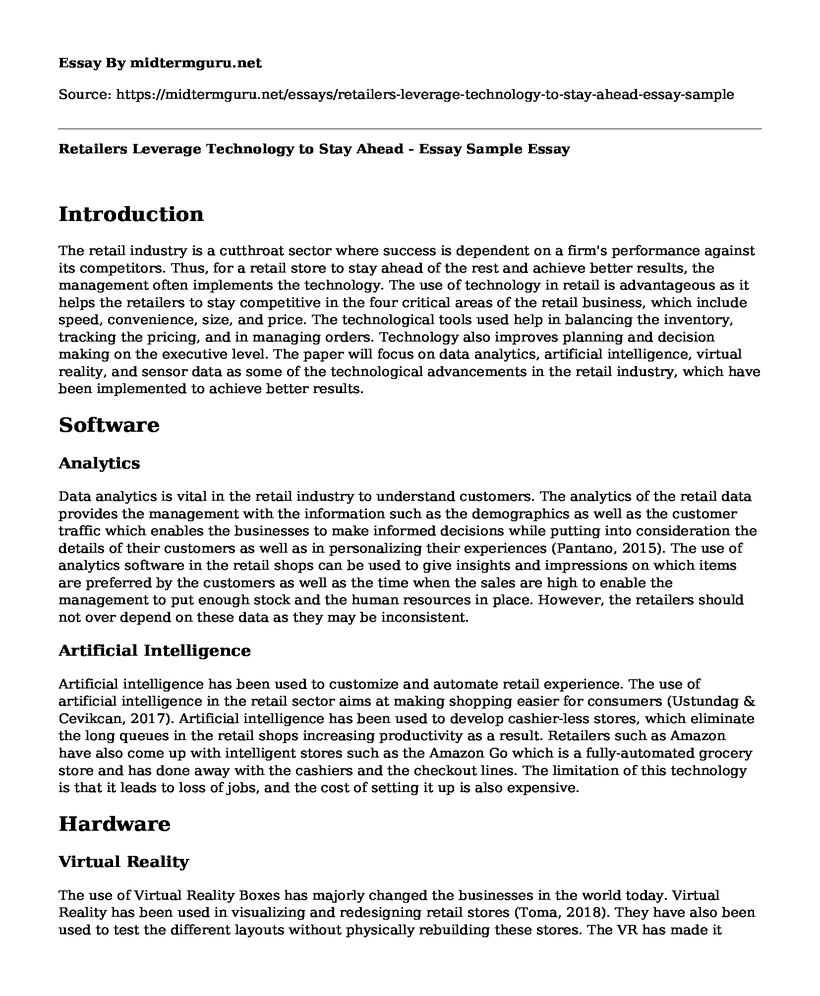Introduction
The retail industry is a cutthroat sector where success is dependent on a firm's performance against its competitors. Thus, for a retail store to stay ahead of the rest and achieve better results, the management often implements the technology. The use of technology in retail is advantageous as it helps the retailers to stay competitive in the four critical areas of the retail business, which include speed, convenience, size, and price. The technological tools used help in balancing the inventory, tracking the pricing, and in managing orders. Technology also improves planning and decision making on the executive level. The paper will focus on data analytics, artificial intelligence, virtual reality, and sensor data as some of the technological advancements in the retail industry, which have been implemented to achieve better results.
Software
Analytics
Data analytics is vital in the retail industry to understand customers. The analytics of the retail data provides the management with the information such as the demographics as well as the customer traffic which enables the businesses to make informed decisions while putting into consideration the details of their customers as well as in personalizing their experiences (Pantano, 2015). The use of analytics software in the retail shops can be used to give insights and impressions on which items are preferred by the customers as well as the time when the sales are high to enable the management to put enough stock and the human resources in place. However, the retailers should not over depend on these data as they may be inconsistent.
Artificial Intelligence
Artificial intelligence has been used to customize and automate retail experience. The use of artificial intelligence in the retail sector aims at making shopping easier for consumers (Ustundag & Cevikcan, 2017). Artificial intelligence has been used to develop cashier-less stores, which eliminate the long queues in the retail shops increasing productivity as a result. Retailers such as Amazon have also come up with intelligent stores such as the Amazon Go which is a fully-automated grocery store and has done away with the cashiers and the checkout lines. The limitation of this technology is that it leads to loss of jobs, and the cost of setting it up is also expensive.
Hardware
Virtual Reality
The use of Virtual Reality Boxes has majorly changed the businesses in the world today. Virtual Reality has been used in visualizing and redesigning retail stores (Toma, 2018). They have also been used to test the different layouts without physically rebuilding these stores. The VR has made it possible to plan the retail shops in ways are that are more logical and convenient to the consumers. The use of VR has also been enhanced with the augmented reality (AR), which enables the consumers to virtually test products saving time as a result. However, the use of this technology is expensive.
Sensor Data
Sensor data has been used in the revolution of the brick and motor retails. Various brands place beacon sensors around their stores which connects to the customer's Bluetooth enabled phones to install the retail app. The installed application allows the retailers to see how long the customers take in their stores as well as what they pick while in the store. The use of these beacons helps in improving productivity by allowing the retailers to make informed decisions (Gilchrist, 2016). The use of this technology brings in the issues with privacy. Thus, retailers must implement it with caution.
Conclusion
Retail businesses require technology in their day-to-day operations. Technology helps retailers to stay competitive in terms of size, price, convenience, and speed. Technology in the retail shops is used in balancing the inventory, tracking the pricing, managing orders, and in making decisions. Various technological advancements exist that retailers can choose from. Analytics is key to the provision of information such as the demographics and customer traffic, which enables the businesses to make informed decisions. Artificial intelligence is used in the customization and automation of the retail experience. Virtual Reality has been used in visualizing and redesigning the retail stores, and sensor data has been used in the revolution of the brick and motor retails.
References
Gilchrist, A. (2016). Industry 4.0: the industrial internet of things. Apress.
Pantano, E. (Ed.). (2015). Successful technological integration for competitive advantage in retail settings. IGI Global.
Toma, C. H. (2018). The Shop of the Future: Bridging the Online/Offline Experience Gap in Fashion Retail Through Virtual Reality. In Fashion and Textiles: Breakthroughs in Research and Practice (pp. 42-68). IGI Global.
Ustundag, A., & Cevikcan, E. (2017). Industry 4.0: managing the digital transformation. Springer.
Cite this page
Retailers Leverage Technology to Stay Ahead - Essay Sample. (2023, Feb 07). Retrieved from https://midtermguru.com/essays/retailers-leverage-technology-to-stay-ahead-essay-sample
If you are the original author of this essay and no longer wish to have it published on the midtermguru.com website, please click below to request its removal:
- Essay on Leadership as One of the Aspects of the Development of Effective Learning Institutions
- What Is Going On With DHS in Strategic Sourcing? - Essay Sample
- C vs JavaScript: Thread Control & Multi-Tasking - Research Paper
- Microsoft Access: Unlocking the Power of Database Management for John - Essay Sample
- Alpha Phi Alpha: Pioneers of African-American Fraternity & Leadership - Essay Sample
- Analysis of Workplace Creative Culture - Essay Sample
- Department Store Increases Sales With New Database System - Essay Sample







